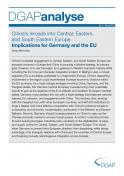Summary
China has considerably increased its engagement in Central, Eastern, and South Eastern Europe in recent years. The creation of the “16+1 Cooperation Framework” in 2012 aroused concerns in Europe that China is pursuing a divisive strategy. Beijing’s primary goal, however, is to use the region as a gateway to Western Europe’s markets while including the EU in its own Eurasian integration project; this suggests that a strong regulatory EU is actually preferable from the Chinese perspective.
Beijing’s deepening involvement in the region could nevertheless increase economic divergencies within the EU as whole – particularly in light of an emerging trade triangle involving China, Germany, and the Visegrad countries that potentially excludes countries in Atlantic and southern Europe and puts the “German-Central European manufacturing core” at an advantage.
Germany should address this risk by developing a triple-edged strategy that carefully balances national interest, European cohesion, and engagement with China. This includes, first, working with the Visegrad Four, with other European countries, and with EU institutions to forge a deeper and more effective cooperation with China to enhance transport connectivity and economic, modernization, particularly in the Western and Eastern Balkans. Second, Germany should increase pressure on China within the framework of the planned EU-China investment agreement for opening up the Chinese domestic market to ensure mutual access. And third, it should promote forward-looking European industrial policy centered on the digitalization of industry, value, and supply chains for Central, Eastern, and South Eastern Europe.
This would allow Germany to prevent intra-European divisions from deepening, while taking advantage of its triangular relations with China and the countries of Central, Eastern, and South Eastern Europe, and fostering mutually advantageous integration across Eurasia.
